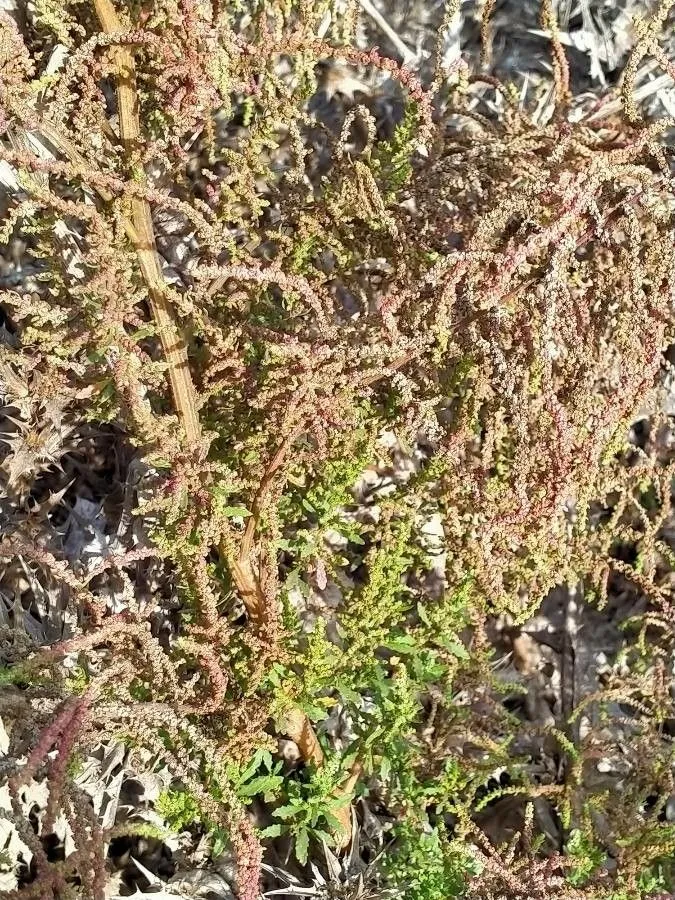
Author: (L.) Mosyakin & Clemants
Bibliography: Ukrayins’k. Bot. Zhurn. 59: 383 (2002)
Year: 2002
Status: accepted
Rank: species
Genus: Dysphania
Vegetable: Unknown
Observations: EC. & S. Europe to Mongolia and C. Himalaya
Jerusalem-oak, scientifically known as Dysphania botrys, is a resilient and sprawling herbaceous plant belonging to the Amaranthaceae family. This species thrives in a diverse array of regions, extending from Eastern and Southern Europe all the way to Mongolia and encompassing parts of the Central Himalayas.
Recognized for its distinctive characteristics and adaptability, Dysphania botrys has garnered considerable attention in various botanical studies, including those referenced in the “Ukrayins’k. Bot. Zhurn. 59: 383 (2002).” First described by prominent botanists Mosyakin and Clemants, this plant presents unique features that make it a subject of interest for both researchers and gardening enthusiasts.
The Jerusalem-oak is often identified by its richly textured, aromatic foliage, which can release a strong, pleasant scent when crushed. This feature, combined with its striking appearance and the ability to grow in varied climatic conditions, makes it not only an attractive plant to observe but also valuable for ecological studies and horticultural purposes. Its adaptability to a wide range of environments highlights its potential for use in disturbed soils or as a part of restoration ecology projects.
Beyond its botanical significance, the plant has also been noted for its historical usage in traditional practices across different cultures within its native range. The resilient growth patterns allow it to prosper in less-than-ideal conditions, which has interesting implications for understanding plant survival strategies and adaptability.
In summary, Dysphania botrys, or Jerusalem-oak, is a remarkable herb with a broad geographical distribution. Its detailed study offers valuable insights into plant ecology, adaptability, and potential applications in various environmental contexts.
Deu: bertholdskraut, klebriger drüsengänsefuß, klebriger gänsefuß
Dan: egebladet gåsefod, klæbrig gåsefod
Eng: feather-geranium, jerusalem oak goosefoot, jerusalem-oak, jerusalem-oak goosefoot, jerusalem oak
Por: ambrósia-dos-boticas
Spa: biengranada
Swe: ekmålla
Fra: herbe à printemps, piment botris, chénopode botrys, chénopode botryde, chénopode en grappe
Nld: druifkruid
En: Jerusalem-oak, Jerusalem-oak goosefoot, Feather-geranium, Jerusalem oak goosefoot, Jerusalem oak, Jerusalem Oak-goosefoot, Sticky Goosefoot
Ar: أثينة عنقودية
Az: İyli tərə
Ca: Bodris
Zh: Xiang li
Da: Egebladet gåsefod, Klæbrig gåsefod
Nl: Druifkruid
Et: Kobar-hanemalts
Fi: Tammisavikka
Fr: Piment botris, Herbe à printemps, Chénopode botrys, Chénopode botryde, Chénopode en grappe, Ansérine à épis, Chénopode à grappes
De: Bertholdskraut, Klebriger Gänsefuß, Klebriger Drüsengänsefuß, Drüsiger Gänsefuß
It: Farinello botri
Pt: Ambrósia-dos-boticas
Es: Biengranada, Hierba hormigera
Sv: Ekmålla
© copyright of the Board of Trustees of the Royal Botanic Gardens, Kew.
© copyright of the Board of Trustees of the Royal Botanic Gardens, Kew.
© copyright of the Board of Trustees of the Royal Botanic Gardens, Kew.
Taken Nov 20, 2016 by Tela Botanica − Liliane ROUBAUDI (cc-by-sa)
Taken Nov 20, 2016 by Tela Botanica − Liliane ROUBAUDI (cc-by-sa)
Taken Nov 20, 2016 by Tela Botanica − Liliane ROUBAUDI (cc-by-sa)
Taken Apr 10, 2005 by Tela Botanica − Liliane ROUBAUDI (cc-by-sa)
Taken Sep 29, 2015 by Tela Botanica − Jacques MARÉCHAL (cc-by-sa)
Taken Oct 7, 2021 by Albert Mallol Camprubí (cc-by-sa)
Taken Oct 15, 2015 by Photoflora – Benoit BOCK (©)
Taken Oct 15, 2007 by Photoflora – Benoit BOCK (©)
Taken Aug 15, 1994 by Photoflora – Jean-Luc TASSET (©)
Taken Jan 1, 1970 by Photoflora – L’Abbé COSTE (©)
Taken Nov 20, 2016 by Tela Botanica − Liliane ROUBAUDI (cc-by-sa)
Taken Apr 10, 2005 by Tela Botanica − Liliane ROUBAUDI (cc-by-sa)
Taken Oct 3, 2014 by Tela Botanica − Ruddy BENEZET (cc-by-sa)
Taken Oct 9, 2021 by Pascal DUPUIS (cc-by-sa)
Taken Oct 3, 2014 by Tela Botanica − Ruddy BENEZET (cc-by-sa)
Taken Oct 26, 2021 by cirse (cc-by-sa)
Taken Oct 26, 2021 by cirse (cc-by-sa)
Taken Oct 7, 2022 by Françoise Boineau (cc-by-sa)
Taken Nov 20, 2016 by Tela Botanica − Liliane ROUBAUDI (cc-by-sa)
Taken Aug 29, 2015 by Tela Botanica − Hugues TINGUY (cc-by-sa)
Taken Apr 10, 2005 by Tela Botanica − Liliane ROUBAUDI (cc-by-sa)
Taken Nov 20, 2016 by Tela Botanica − Liliane ROUBAUDI (cc-by-sa)
Taken Sep 29, 2015 by Tela Botanica − Jacques MARÉCHAL (cc-by-sa)
Family: Myrtaceae Author: (F.Muell.) K.D.Hill & L.A.S.Johnson Bibliography: Telopea 6: 402 (1995) Year: 1995 Status:…
Family: Rubiaceae Author: Pierre ex A.Froehner Bibliography: Notizbl. Bot. Gart. Berlin-Dahlem 1: 237 (1897) Year:…
Family: Sapindaceae Author: Koidz. Bibliography: J. Coll. Sci. Imp. Univ. Tokyo 32(1): 38 (1911) Year:…
Family: Asteraceae Author: A.Gray Bibliography: Pacif. Railr. Rep.: 107 (1857) Year: 1857 Status: accepted Rank:…
Family: Fabaceae Author: Medik. Bibliography: Vorles. Churpfälz. Phys.-Ökon. Ges. 2: 398 (1787) Year: 1787 Status:…
Family: Aspleniaceae Author: (Cav.) Alston Bibliography: Bull. Misc. Inform. Kew 1932: 309 (1932) Year: 1932…